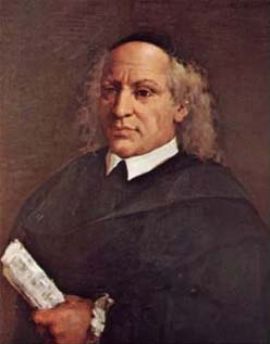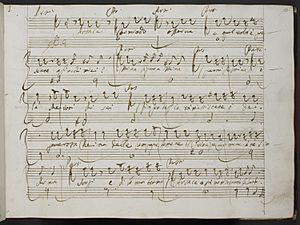Leonardo Vinci facts for kids
Quick facts for kids
Leonardo Vinci
|
|
|---|---|

Portrait of Vinci, perhaps a late 18th/early 19th-century copy
|
|
| Born |
Leonardo Vinci
1690 Strongoli, Kingdom of Sicily
|
| Died | 27 May 1730 |
| Occupation | Composer |
Leonardo Vinci (born in 1690 – died on May 27, 1730) was an Italian composer. He is mostly known for his many operas, which are like musical plays. He wrote about 40 operas! Not much of his other music has survived.
Vinci was a very important part of the Neapolitan School of opera. This was a group of composers in Naples who created a special style of opera. His music greatly influenced other famous opera composers like Johann Adolph Hasse and Giovanni Battista Pergolesi.
Contents
His Life and Career
Leonardo Vinci was born in a town called Strongoli. He studied music in Naples at a school called the Conservatorio dei Poveri di Gesù Cristo. His teacher was Gaetano Greco.
Vinci first became famous in 1719 for his opere buffe, which are funny or comic operas. These were often sung in the Neapolitan language. He also wrote many opere serie, which are serious and dramatic operas.
He joined a religious group called the Congregation of the Rosary in 1728. Vinci passed away in May 1730. Some stories say he died mysteriously, possibly due to an illness or even poison. However, we don't have clear proof of how he died.
What Kind of Music Did He Write?
Vinci's comic operas, like Li zite 'ngalera (from 1722), are known for being lively and full of energy. His serious operas, such as Didone Abbandonata (from 1726) and Artaserse (from 1730), are powerful and dramatic.
A famous music historian named Charles Burney praised Vinci's music. Burney said that Vinci was one of the first opera composers to make music simpler and clearer. He helped audiences focus on the singing, making it less complicated and easier to enjoy.
A good example of his style is the well-known song "Vo solcando" from his opera Artaserse.
His Operas
Here is a list of some of the operas Leonardo Vinci composed:
- Le doje lettere (1719)
- Lo cecato fauzo (1719)
- Lo scagno (1720)
- Lo scassone (1720)
- Lo Barone di Trocchia (1721)
- Don Ciccio (1721)
- Li zite 'ngalera (1722)
- La festa di Bacco (1722)
- Publio Cornelio Scipione (1722)
- Lo castiello sacchiato (1722)
- Lo labberinto (1723)
- Semiramide (1723)
- Silla dittatore (1723)
- L'Eraclea (1724)
- Farnace (1724)
- La mogliera fedele (1724)
- Turno Aricino (1724)
- Ifigenia in Tauride (1725)
- La Rosmira fedele (1725) also known as Partenope (1725)
- Il trionfo di Camilla (1725)
- Elpidia (1725)
- L'Astianatte (1725)
- Didone abbandonata (1726)
- Siroe, Re di Persia (1726)
- L'asteria (1726)
- Ernelinda (1726)
- Gismondo, Rè di Polonia (1727)
- La caduta dei Decemviri (1727)
- Il Medo (1728)
- Catone in Utica (1728)
- Flavio Anicio Olibrio (1728)
- Alessandro nell'Indie (1729)
- Farnace (1729)
- La Contesa dei Numi (1729)
- Massimiano (1729)
- Artaserse (1730)
Other Musical Pieces
Besides operas, Vinci also wrote other types of music. These include:
- Several cantatas (pieces for one or more singers with instruments).
- Sonatas (pieces for one or two instruments).
- A serenata (a type of evening performance).
- Two oratorios (large musical works, usually on a religious theme, like an opera but without costumes or staging).
His sonata in D major for flute and basso continuo (a type of accompaniment) is still played today. He also wrote two sonatas for the recorder and a recorder concerto (a piece for a solo recorder with an orchestra).
See also
 In Spanish: Leonardo Vinci para niños
In Spanish: Leonardo Vinci para niños


